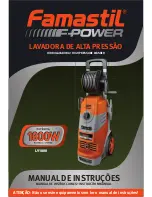
8
USER MANUAL
TUNWAS12-100
v.1.1
EQUIPMENT SAFETY
After opening the carton, unpack the washer and related parts and accessories. Inspect the equipment for any damage that may have occurred
during transit, contact your nearest Tundra Dealer is any damage or defects are discovered. Check that all nuts and bolts are secure before putting
the washer into operation.
Warning:
Do not use this equipment is damaged or defective in any way.
This equipment should only be operated by qualified and responsible individuals who have read and
understood the information and guidelines described in this document. In particular, the following safety instructions should be followed to reduce
the risk of injury to the operator and members of the public.
•
Familiarise yourself with this equipment and its operation before use -
read this user manual carefully before use
. Save for future reference.
•
This appliance is for outdoor use only. Ensure that all bystanders are kept at a safe distance and that animals and children are kept from the
work area.
•
This appliance has been designed for use with detergents specified by the manufacturer (for example neutral shampoo based on
biodegradeable anionic surface active detergents). Do not use any chemicals that will corrode the coating materials of the high pressure hose
or pump.
Do not use bleach, alcohol, petrol, or hydrochloric acid in the detergent reservoir.
Please consult the manufacturer for
advise before using other detergents or chemicals in order to prevent damage to the equipment and the environment.
•
Do not direct the nozzle towards mechanical parts containing lubricant grease. High pressure jet can be harmful and dangerous always
ensure a safe working distance when spraying objects and assess and fix the appropriate nozzle for the job at hand.
•
The high pressure jet can cause loose particles to be propelled at high speed - always appropriate protective clothing. Safety goggles must
always be worn when using this equipment.
•
Never point the high pressure hose directly at people animals, live electrical parts or the appliance itself.
•
The appliance operates at fluid pressures and velocities high enough to penetrate human and animal flesh. Do not treat fluid injection caused
by accident or misuse of this equipment as a simple cut injury -
seek medical advice immediately.
•
Do not step or stand on the high pressure hose and ensure that the hose is clean, free from debris, obstructions and kinks before use.
Always unwind the hose fully before use.
•
Check and ensure that the nozzle has been fitted correctly before use as the high pressure can result in the nozzle being "fired" from the
lance with considerable force if not fitted correctly.
•
Beware of kick-back force and the sudden torque on the spray gun assembly when operating the trigger. Grip the gun firmly to counteract the
recoil.
•
Ensure that you have evaluated the pressure required for the job at hand and selected the appropriate nozzle before use. High pressure
jets can remove paint and other specialised surface treatments (including alloy wheel lacquer). High pressure jets may also breakdown and
remove the grouting between paving slabs and can even damage tarmac.
•
Always shut the equipment off completely when not in use and if left unattended.
•
Do not operate this equipment in an explosive atmosphere, near combustible materials.
•
Discharge any residual pressure from the lance before disconnecting the high pressure hose.
•
The operating temperature of the water supply should be within a standard range of 1
°
C - 50
°
C.
•
Only approved engineers should carry out repairs and maintenance on this equipment. Only use approved replacement parts to repair this
equipment. Never modify the equipment in anyway. Ensure that the equipment is kept in good working order and cleaned and serviced
regularly. Regularly check external nuts and fixings to ensure that they have not loosened from vibration during use.






































